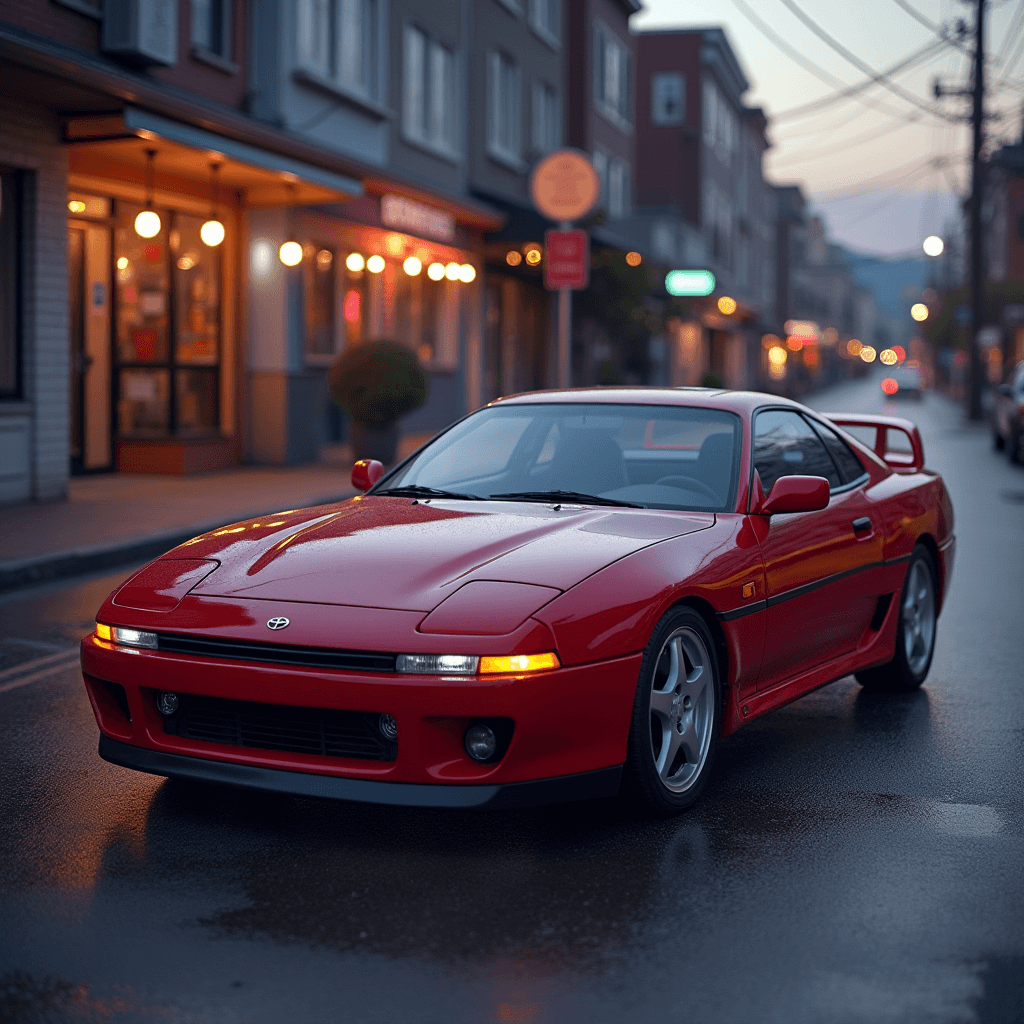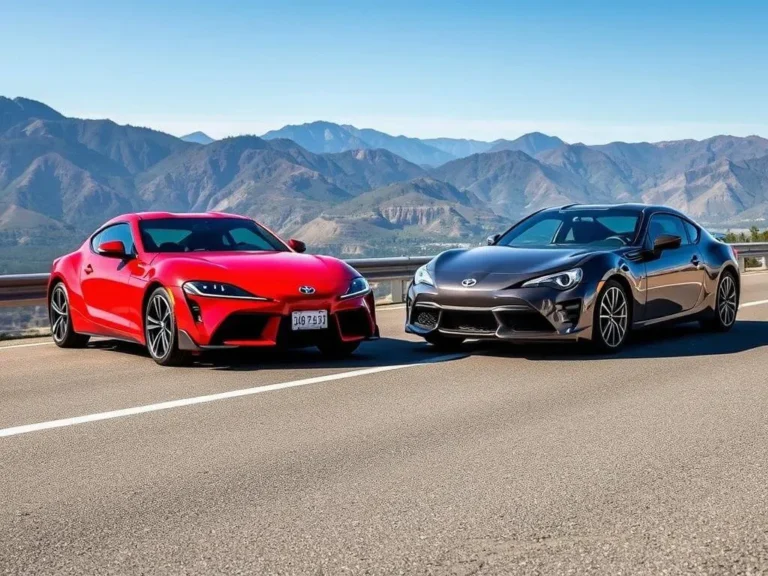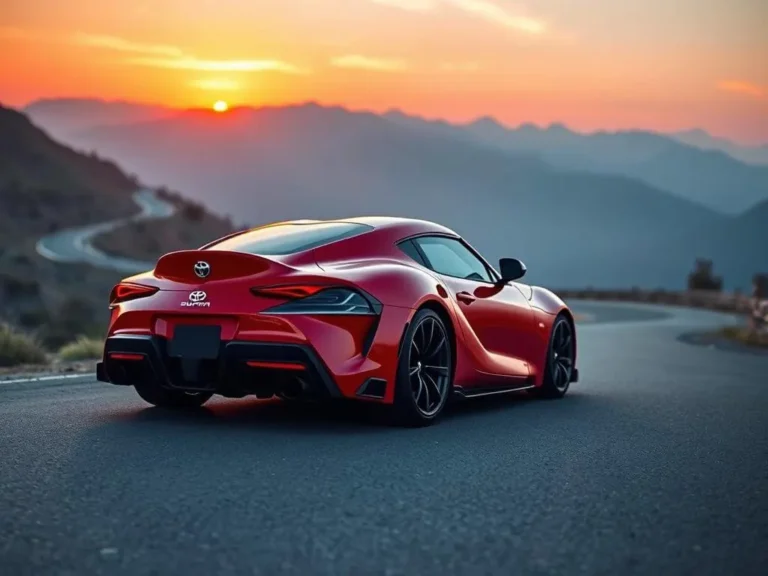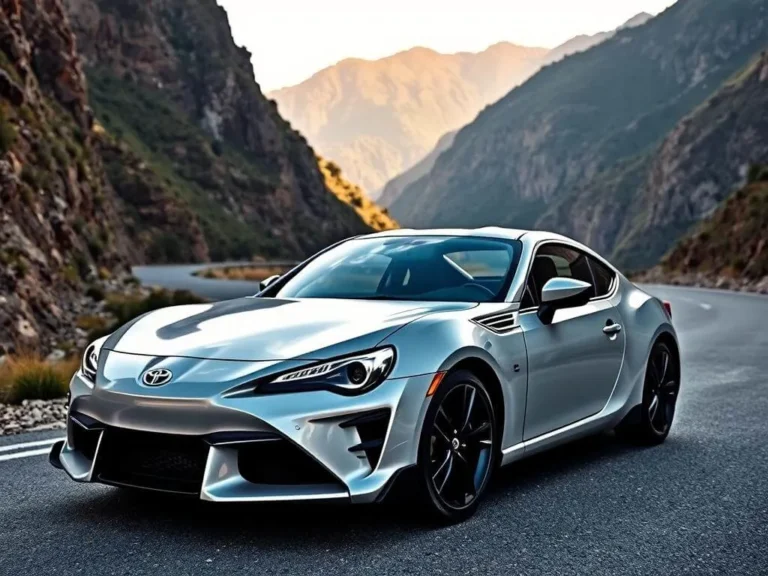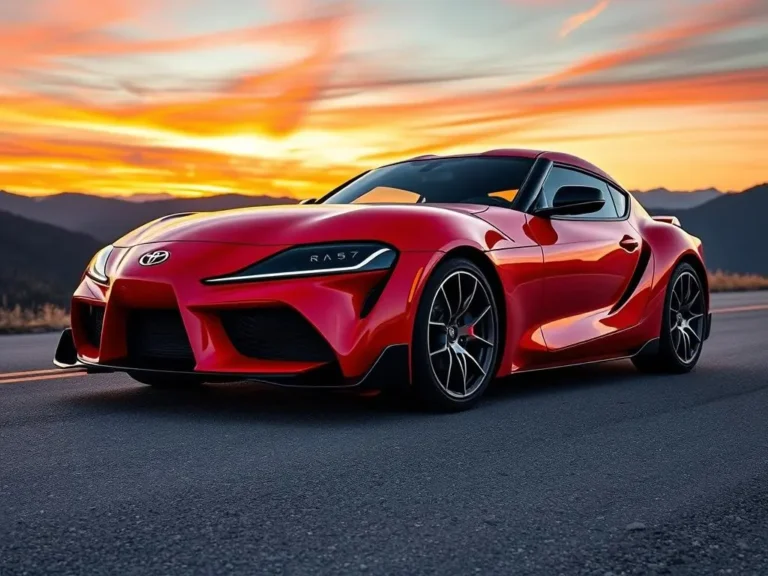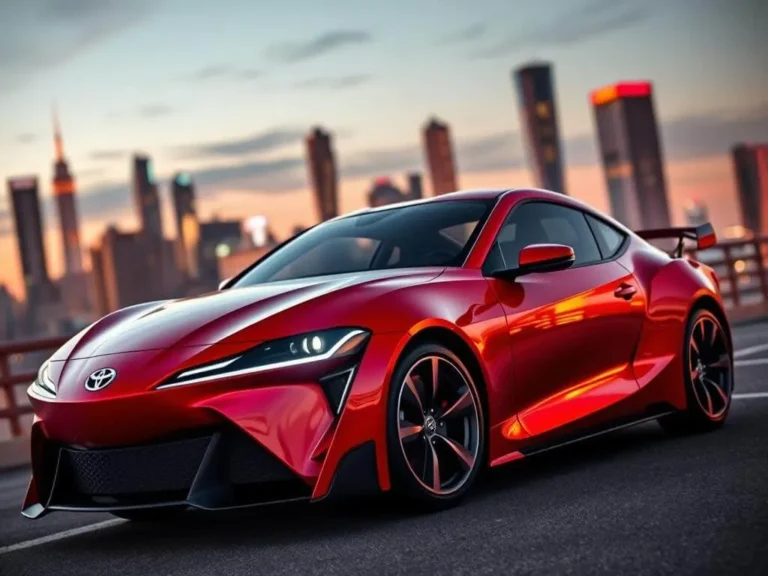1992 Toyota Supra: Ultimate JDM Sports Car Review
The 1992 Toyota Supra was a true icon in the golden era of Japanese sports cars. It was known for its powerful twin-turbo engine, iconic styling, and exceptional handling. But what makes the 1992 Toyota Supra the ultimate JDM sports car? Let’s dive into its rich history, impressive engineering, and lasting legacy.
What set the 1992 Toyota Supra apart from its rivals? And why has it become such a lasting icon in sports cars? As you explore further, you’ll discover the story of a sports car that redefined performance and left a mark on automotive culture.
Table of Contents
The Evolution of Toyota’s Legendary Sports Car
The Toyota Supra started as a Celica variant in the late 1970s. But the third-generation (MK3) Supra, launched in 1986, was the first to stand alone. It had rear-wheel drive and cutting-edge tech. This change marked the Supra’s journey to becoming a famous sports car.

From Celica Origins to Independent Model
The Supra’s roots are in the Toyota Celica, a well-loved sports car. But the MK3 Supra was different. It was its own model, not based on the Celica. This change let Toyota focus on making the Supra fast and powerful, starting its journey as a top JDM sports car.
The Birth of an Icon
The fourth-generation (MK4) Supra, introduced in 1993, became a true icon. Its sleek design and the famous 2JZ engine won over fans everywhere. Toyota’s focus on racing and the Supra’s performance made it a legend among sports cars.
Racing Heritage and Development
Toyota’s racing team was key in making the Supra fast and competitive. Their motorsports know-how helped add top-notch tech to the Supra. This made it a champion on the track, setting records and winning races.
Design Philosophy and Exterior Styling
The 1992 Toyota Supra marked a big change from its boxy past. It showed off a sleek and curved look that made it a standout 90s Japanese coupe. The design aimed to be both stylish and aerodynamic, boosting speed and stability.
The Toyota mk4 Supra was known for its long, sloping hood. It smoothly connected to the car’s strong body. The pop-up headlights gave it a modern look. The rear featured an iconic adjustable wing, adding downforce for better performance.
The Supra’s design was more than just looks. It was made to improve aerodynamics. Its shape and aerodynamic parts helped it stay stable and agile at high speeds. This made it a great car for both street and track driving.
In short, the 1992 Toyota Supra combined beauty and power. It was a sports car that looked good and drove even better, offering an exciting ride.
1992 Toyota Supra Performance Specifications
The 1992 Toyota Supra was a top performer among JDM sports cars. It had a 3.0-liter twin-turbocharged inline-six engine, known as the 2JZ-GTE. This engine produced 276 horsepower and 268 lb-ft of torque.
It could go from 0 to 60 mph in just 5.1 seconds. The Supra’s top speed was an amazing 156 mph. This made it a true high-performance Toyota sports car.
Engine Output and Capabilities
The Supra’s heart was the 2JZ-GTE engine. This twin-turbocharged inline-six was famous for its tuning potential. Many enthusiasts could get up to 326 horsepower from it with upgrades.
Transmission and Drivetrain Details
The 2JZ-GTE engine’s power went through a strong Getrag 6-speed manual transmission. This gave the driver precise control. The Supra’s rear-wheel-drive and advanced suspension made it great for handling and cornering.
Performance Metrics
- 0-60 mph acceleration: 5.1 seconds
- Top speed: 156 mph
- Curb weight: 3,430 lbs (1,560 kg)
The Supra’s performance was boosted by weight reduction. It used aluminum components to improve its power-to-weight ratio and handling.
The Legendary 2JZ-GTE Engine
The Toyota Supra’s heart is the 2JZ-GTE engine. It shows Toyota’s top engineering skills. This twin-turbo inline-six is known for its durability, tuning potential, and performance.
The stock 2JZ-GTE engine made 320 horsepower. This was thanks to its twin-turbo setup. Its strong build and high boost tolerance made it a hit with tuners and racers.
| Engine | Displacement | Horsepower | Torque |
|---|---|---|---|
| 2JZ-GTE | 3.0L | 280 – 320 hp | 220 – 325 lb-ft |
| 1JZ-GTE | 2.5L | 276 hp | 268 lb-ft |
| 5M-GE | 2.8L | 232 hp | N/A |
| M-TEU | 2.0L | 160 hp | 170 lb-ft |
| 4M-E | 2.4L | 110 hp | 136 lb-ft |
The 2JZ-GTE’s design is more than just power. Its twin-turbochargers offer smooth power, strong torque, and high performance. This makes it great for both street and track driving.
The 2JZ-GTE’s long life shows its engineering excellence. Made for 17 years, from 1991 to 2007, it’s a legendary engine. Its adaptability and versatility have won it fans worldwide.
Advanced Engineering and Technology
The 1992 Toyota Supra showed Toyota’s dedication to innovation and performance. This legendary jdm sports car had advanced engineering features. These made it stand out in the japanese performance car world.
Suspension System Innovations
The Supra’s handling was thanks to its double-wishbone suspension system. Toyota’s Electronically Modulated Suspension (TEMS) adjusted shock absorbers for road conditions. This technology balanced ride comfort and precise cornering, making driving a pleasure.
Aerodynamic Advancements
The 1992 Supra’s design improved high-speed stability and reduced lift. Its body shape and rear spoiler created a sleek profile. These features not only boosted performance but also made the Supra eye-catching on the road.
| Feature | Description |
|---|---|
| Suspension System | Double-wishbone suspension with Toyota Electronic Modulated Suspension (TEMS) for adaptive damping |
| Aerodynamics | Sculpted body shape and effective rear spoiler for enhanced high-speed stability and reduced lift |
Interior Features and Comfort
The 1992 Toyota Mk4 Supra’s interior was a mix of sportiness and luxury. It was made for those who loved grand tours in a JDM sports car. The seats were supportive and adjustable, covered in premium leather. It also had an electronic climate control and a detailed instrument cluster, making it a high-performance machine.
The Supra was big, measuring 178 inches long, 71 inches wide, and 50 inches tall. It had a 100.4-inch wheelbase and weighed between 3,210 and 3,505 pounds. Its cockpit was inspired by fighter jets, with a split glovebox and lots of storage. This made the car feel spacious and practical.
| Interior Dimensions | Measurements |
|---|---|
| Length | 178 inches |
| Width | 71 inches |
| Height | 50 inches |
| Wheelbase | 100.4 inches |
| Front Track | 59.8 inches |
| Rear Track | 60 inches |
| Curb Weight | 3,210 to 3,505 pounds |
The Toyota Mk4 Supra was the first Toyota with a passenger-side airbag. This made it safer and more comfortable for passengers. The interior was filled with high-quality materials, showing the Supra’s reputation as a luxurious JDM sports car.
Driving Experience and Handling
The 1992 Toyota Supra offered an exceptional driving experience. It blended track performance with daily usability perfectly. Its robust chassis, well-tuned suspension, and powerful brakes made it a true Japanese performance car.
Track Performance
On the track, the Toyota Supra showed impressive cornering and high-speed stability. Its 2JZ-GTE engine and balanced suspension allowed it to tackle corners with confidence. Drivers enjoyed responsive steering, excellent grip, and control even at high speeds.
Daily Usability
Despite its track prowess, the Supra was great for daily driving. It had a comfortable ride quality, making it practical for commuting and long trips. Its interior was well-designed, and the cabin was spacious, making it enjoyable for everyday use.
The 1992 Toyota Supra stood out for its balance between track performance and daily usability. It was a true standout among toyota sports car and japanese performance car offerings. Drivers could enjoy its handling and practicality every day.
Comparing the Supra to Contemporary JDM Rivals
In the 1990s, the 1992 Toyota Supra battled it out with other jdm sports car icons. These included the Nissan 300ZX, Mazda RX-7 FD, and Honda NSX. Each had its own special performance and design.
The Supra was a bit heavier than some rivals. Yet, it offered great speed, handling, and comfort. Its 2JZ-GTE twin-turbo engine could hit up to 320 horsepower, making it a powerhouse.
The Mazda RX-7 FD was a tough opponent. It had a lightweight rotary engine and sharp handling. Its 1.3-liter twin-turbo engine made 252 horsepower, reaching speeds of 155 mph.
Honda’s NSX was known for its refined design and 3.0-liter V6 engine. It produced 270 horsepower and was great for everyday driving. The NSX was a strong competitor to the Supra’s power and comfort.
In the end, the Toyota Supra stood out in the 1990s jdm sports car market. Its mix of performance, tunability, and practicality made it a legend among Japanese sports cars.
Tuning Potential and Aftermarket Support
The 1992 Toyota Supra, with its famous 2JZ-GTE engine, was a hit among tuners. Its top-notch engineering made it perfect for performance upgrades. Enthusiasts loved to tweak it to reach its full potential.
Popular Modifications
Supra owners went for various aftermarket upgrades to boost performance. Some key changes included:
- Upgraded turbochargers for more boost and power
- Intercooler upgrades for better cooling
- Enhanced exhaust systems to reduce backpressure
- ECU tuning for better engine management
Power Enhancement Options
The 2JZ-GTE engine was strong and reliable, making it great for power boosts. With the right tweaks, owners could push the engine over 1,000 horsepower. This made the Supra a true performance legend, rivaling exotic supercars.
| Engine | Potential Horsepower |
|---|---|
| Toyota 2JZ-GTE | Over 1,000 hp |
| Nissan RB26DETT | Over 1,000 hp+ |
| Mitsubishi 4G63 | Supercar-killing Evos |
| Honda K20 | Over 700 hp |
| Subaru EJ20 | Powering 8-second drag cars |
| BMW N54 | Over 700 hp |
| Mazda 13B | Around 1,000 hp+ |
| GM LS Series | Over 1,500 hp |
The Supra had a lot of aftermarket support. This meant enthusiasts could find high-quality parts. They could turn their cars into true icons in the tuner culture and import performance world.
Impact on Car Culture and Media
The 1992 Toyota Supra has made a big impact on car culture, especially in the jdm sports car tuner scene. Its fame comes from being in many popular media, making it a symbol of the 90s.
The Supra’s design and speed have made it a favorite in video games like Gran Turismo and Need for Speed. These games have introduced the Supra to many, sparking a love for its performance and customization.
The Supra’s biggest media moment was in The Fast and The Furious movies. It was Brian O’Conner’s car, showing off its speed and style. This made the Supra even more popular in the tuner world.
Thanks to media, the Supra’s popularity has grown, helping the jdm sports car community grow too. Its legendary status has led to many customizations and upgrades, keeping its 90s tuner spirit alive.
| Media Appearances | Impact on Tuner Culture |
|---|---|
|
|
Market Value and Investment Potential
The 1992 Toyota MK4 Supra has seen a remarkable increase in market value. This is especially true for well-maintained or low-mileage examples. Its status as a highly collectible jdm sports car has grown. This is due to its exceptional performance, cultural significance, and relative rarity.
Collectibility Factors
Several factors contribute to the toyota mk4 supra‘s growing collectibility. Its potent 2JZ-GTE engine and advanced engineering are favorites among enthusiasts. The Supra’s rich racing heritage and enduring popularity in popular culture also add to its desirability.
Price Trends
- A 1993-1998 Toyota Supra has shown a 104% appreciation in value over the past five years, reaching $109,700.
- In comparison, a 1984-2001 Jeep Cherokee has appreciated by 101% to $17,700 in the Top 5 trucks segment.
- The sports car category includes a 1996-2002 BMW Z3/M Roadster which has gone up by 48% to $32,900.
- Vintage cars like a 1970-1979 Lincoln Continental have appreciated by 69% to $22,700.
These price trends show the consistent appreciation of the toyota mk4 supra. Some pristine examples fetch six-figure sums at auctions. The Supra’s investment potential remains strong due to its iconic status and enduring popularity.
| Model | Current Average Market Price | Value Increase in the Past 10 Years |
|---|---|---|
| 1994 Toyota Celica Mk6 | 7,297€ | +105% |
| 1986 Toyota Supra Mk3 | 16,367€ | +44.5% |
| 2003 Nissan 350Z | 18,607€ | +47.2% |
| 1991 Mazda RX-7 | 24,170€ | +143% |
| 1979 Jaguar XJ | 24,026€ | +97.9% |
| 1968 Chevrolet Corvette | 32,432€ | +29.7% |
| 1992 Maserati Ghibli | 32,633€ | +39.4% |
| 1969 Alfa Romeo GT Junior | 40,904€ | +41.2% |
| 1994 Ferrari F355 | 111,935€ | +31.7% |
| 1973 Porsche 911 Carrera RS | 432,610€ | +64.9% |
Known Issues and Maintenance Considerations
The 1992 Toyota Supra is a legendary sports car. But, it has its own set of known issues. These problems are common, especially with the 2JZ-GTE engine.
One big issue is oil leaks. They often start from the valve cover gaskets. These gaskets can wear out, causing oil to leak. It’s important to check and replace them regularly to keep the Supra in top shape.
The turbocharger system can also be a problem. High-mileage Supras might see their turbocharger wear out or fail. Keeping up with oil changes and watching for turbo issues is key to maintaining the Supra’s performance.
- Oil leaks from the valve cover gaskets
- Potential turbocharger failures in high-mileage Supras
- Wear on suspension components
The Supra’s suspension parts, like bushings and ball joints, can also wear out. This can affect how the car handles and rides. It’s important to check and replace these parts when needed to keep the Supra’s legendary feel.
The 2JZ-GTE engine is known for its durability and tuning potential. But, it still needs regular care and maintenance. Keeping up with oil changes, watching for fluid leaks, and following the maintenance schedule are all crucial for the Supra’s power and reliability.
| Issue | Description | Maintenance Recommendation |
|---|---|---|
| Oil Leaks | Valve cover gasket deterioration leading to oil seepage | Regularly inspect and replace valve cover gaskets as needed |
| Turbocharger Failure | Wear and tear on the turbocharger, especially in high-mileage Supras | Perform regular oil changes and monitor for any turbo issues |
| Suspension Wear | Deterioration of bushings, ball joints, and other suspension components | Regularly inspect and replace worn suspension parts as necessary |
By keeping up with maintenance and addressing these common issues, owners can ensure their 1992 Toyota sports car stays in top condition. This will help it continue to deliver the thrilling driving experience that has made it a JDM icon.
Buying Guide: What to Look For
When looking to buy a 1992 Toyota Supra, it’s key to check a few important areas. This ensures you get a car that’s well-kept and genuine. The toyota mk4 supra is a top choice, and doing your homework can save you from trouble.
Common Problem Areas
First, look at the engine bay for leaks or changes not done by Toyota. The jdm sports car‘s 2JZ-GTE engine is strong, but check its state. Also, check the body for rust, especially where water might collect.
Don’t forget to check the suspension parts for wear. The Supra’s great handling depends on these parts. Look at the bushings, shocks, and struts closely.
Documentation Requirements
- Get a full maintenance history, including big repairs or changes.
- Make sure the ownership history is clear and all documents are there, like the title and registration.
- If the car has been modified, check if the parts fit well and are of good quality.
It’s wise to have a toyota mk4 supra expert inspect the car before you buy. With the right care, the 1992 Toyota Supra can be a great jdm sports car to own.
Racing Heritage and Motorsport Success
The toyota sports car has a rich racing history. It has competed in many motorsport events and achieved great success. Toyota first showed its motorsport interest in 1957, entering a car in the Round Australia Trial and finishing third in foreign entries.
Over time, Toyota’s racing efforts grew a lot. In 1981, TRD USA started in an American motorsport series with a Celica. They won the GTO class in 1987. Racer Ivan Stewart won 84 events and 10 championships by the late 1980s, including 17 Baja 500 wins.
Toyota’s success wasn’t just in North America. Toyota Team Europe (TTE) won its first World Rally Championship in 1975 with Hannu Mikkola. The Celica TCT became known as the “King of Africa” after winning the Safari Rally Kenya and the Ivory Coast Rally in 1983.
The japanese performance car also excelled in endurance racing. Toyota first reached the podium at the 24 Hours of Le Mans in 1992, finishing second. TRD USA’s Eagle MkIII dominated the IMSA series, winning 21 out of 27 races in the GTP class in 1991.
In the 1990s, Toyota’s racing success continued. They won the World Rally Championship manufacturers’ titles in 1993 and 1994. However, they were banned in 1995 due to a turbo restrictor device controversy. In Japan, Toyota broke several records and won championships in 1995.
The Supra’s racing history has made it a serious sports car. It has also influenced the development of future road models. This ensures the legacy of this iconic toyota sports car continues to inspire fans and racers.
Cultural Impact and Legacy
The 1992 Toyota Supra has made a lasting impact on car culture. It has influenced car design, tuning trends, and fan communities around the world. The Supra name lives on in the current GR Supra model.
The MK4 Supra’s influence on the tuner scene is huge. Its legendary 2JZ-GTE engine has inspired countless performance upgrades. Its sleek design and advanced engineering have inspired many to push car limits.
The Supra’s impact goes beyond the tuner scene. It has appeared in blockbuster movies and hit video games like Gran Turismo. It has become a symbol of the golden age of JDM sports cars, blending performance, style, and tuning potential.
Did You Like This Article?
Celica come back
Very informative and useful, details.
Good article
A lot information, thanks
Top top toyota
Celica 2025 is a top model of Toyota,
New Celica
I drove an ’81 from ’85 til ’99 and loved it. Then I got my first Nissan 240 SX. Twenty five years later, I’m on my fourth 240. Any chance of a 240SX comeback?
Toyota riders . Com
Very informative

